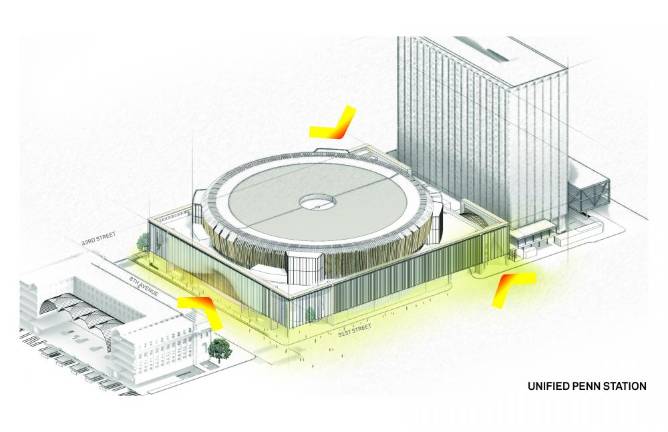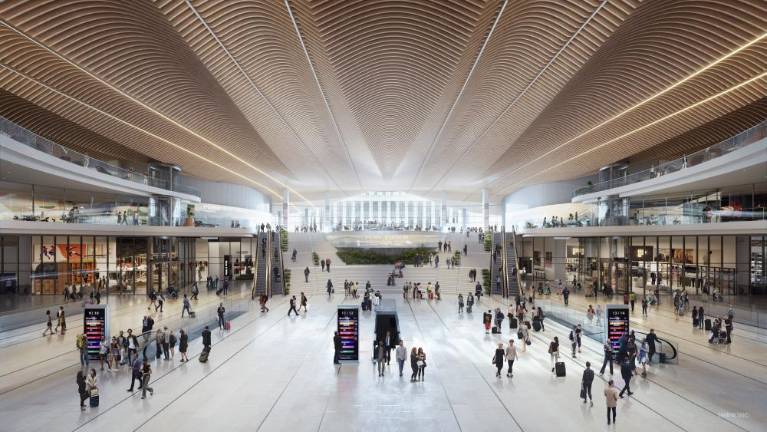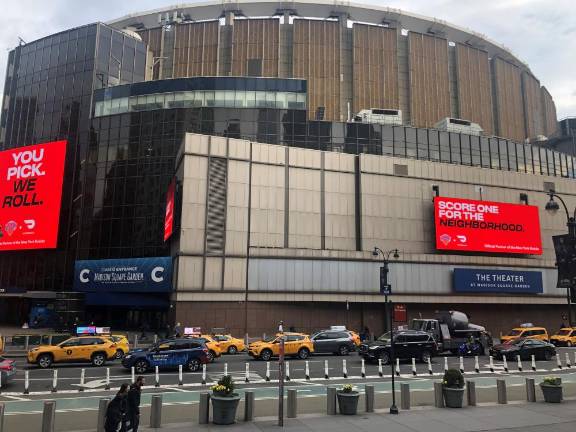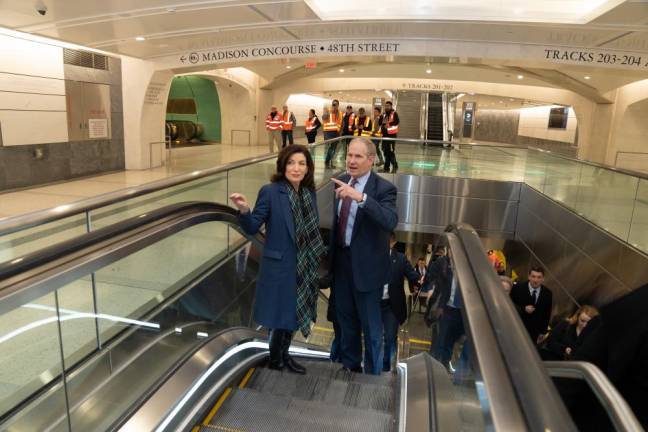Penn Station Re-Do: Hochul Ponders Plan That Would Meld Public/Private Partnership
With Vornado’s towers plan stalled, Governor Kathy Hochul is now listening to a new plan from the North American subsidiary of an Italian construction giant on how to build and pay for the renovation of Penn Station. The company, ASTM, proposes a public private partnership to run Penn Station.




An Italian company that builds and operates highways and other public works around the world has suddenly transformed the debate over the future of Penn Station. The company, ASTM, has won the ear of Governor Kathy Hochul with a plan that is most radical not for what it proposes to do to Penn Station but for how it proposes to pay for it.
For years now, Governor Hochul, and Governor Andrew Cuomo before her, have been proposing to pay the state’s share of the renovation of the dank and dinghy Penn Station with revenue siphoned from a massive redevelopment of the surrounding neighborhood. But with that plan, officially known as the GPP, moribund because of soaring interest rates and plunging office use, ASTM’s North American subsidiary stepped in with a different offer: they would help finance the rebuilding themselves.
“This is an important day,” said Alexandros Washburn, an urban planner and fierce critic of present plans for Penn Station and the neighborhood, “because it shows that international capital and global p3 (Public-Private Partnership) is interested.”
Officials who have been briefed on the plan say that ASTM would invest a substantial amount of its own capital–perhaps a billion dollars–in the renovation. Among other things, ASTM would buy the HULU theatre from Madison Square Garden, demolish it and use that open space to create a much grander Eight Avenue portal to Penn Station.
“Our team has developed a game-changing plan to fully deliver on Gov. Hochul’s new vision for a reimagined Penn Station that is iconic, spacious, accessible, and full of light and air, as well as improves the functionality for all users,” said the CEO of ASTM Group, Chris Larsen. The CEO of ASTM’s North American subsidiary is Pat Foye, who has run both the MTA and the Port Authority and has been integral in presenting the companies proposal for Penn Station to state and city officials and neighborhood representatives in recent weeks. “We will continue to work closely with all stakeholders and community leaders to deliver a new Penn Station that uplifts the community and makes all New Yorkers proud,” Larsen said, “while limiting risk to taxpayers through an innovative development approach."
Hochul’s previous plans for improving Penn Station relied on millions of dollars in future revenue from a development plan to build ten towers, mostly offices, in the surrounding neighborhood and siphoning some of what would have been property taxes to pay the state’s share of the rebuilding. That plan has generated fierce local opposition and, in any case, the principal developer, Vornado Realty Trust, has said that it can’t proceed at the moment because of the economic headwinds. Instead, ASTM proposes a scheme now common in other infrastructure projects. The company would build and operate the station and recoup its investment from revenues generated by the ongoing operations.
ASTM, for example, describes itself as the world’s second largest operator of toll highways, including in Italy and Brazil. That’s a relatively straightforward business where tolls from highway users pay back government bonds and private capital used to build and maintain the highways. A similar model is now also popular for airport terminals, including at JFK airport, where fees from airlines and concessionaires in the terminals provide lucrative revenue streams to private operators. How this would work for a rail station, whose principal users are the now government-run remnants of bankrupt railroads was not made entirely clear in ASTM’s initial statement.
“We’re going to have to figure out how this can work for a train station,” said LaylaLaw-Gisiko, who chairs the land use committee of Community Board Five. She welcomed the proposal as a breakthrough that effectively killed the old GPP plan, while saying key issues remained. Renderings distributed by ASTM do show numerous classy-looking clothing boutiques and other shops on both the main level of the proposed station and two terrace like mezzanines. How much of the costs could be covered by revenue from this mall-like feature, replacing the donut shops and bars of the present Penn Station, was not described. The community board is pressing forward with its larger review of plans for the station and the neighborhood. A hearing is scheduled for April 18 at 6:30 to discuss how to go forward, Law-Gisiko said.
While ASTM’s proposal clearly changes the conversation it does not appear to settle all the issues. “It is not enough,” said Samuel Turvey, a leading proponent of a new above ground Penn Station.”
Most significantly, while the plan opens the west end of Penn Station to more light and air by removing the theatre nestled against the larger arena, it leaves that larger arena in place.
Many advocates say a truly improved station is ultimately only possible by moving MSG and removing all the columns that run down through the station it sits on top of.
“We stand by the need for a great above-ground station that does not have to perform a contortionist’s act to fit–Rubik cube style–under Madison Square Garden or 2 Penn Plaza,” said Turvey. This would create space for larger platforms and better train operations.
The Garden’s special permit to operate the arena expires July 28 and so the two issues–the future of the Garden and the future of Penn Station–have merged in many quarters into one debate. James Dolan, MSG’s owner, is under intense pressure on several related fronts. He has outraged many community and political leaders by using facial recognition technology to identify and bar from his facilities lawyers who work for firms that have brought actions against his companies. A state appellate court this week lifted a restraining order on this practice, but effectively ruled that Dolan would have to pay $500 each time someone is denied admission. Potentially far more costly to MSG, is the fight underway over the property tax break Mayor Koch granted the Garden at a time in the early 1980’s when Dolan was threatening to take his teams, The Knick and The Rangers, out of town. The city’s Independent Budget Office reported last week that the value of this breakwas probably much higher than the $42 million figure cited. This, the Budget Office said, is because no one bothers putting time into updating the assessed value of The Garden, knowing that it pays no taxes.
Through all of this Dolan has maintained that he does not want to move The Garden because it is so well located to a transit hub, that is, Penn Station. But one of his executives said recently that moving across Seventh Ave might work.
In the meantime, Janno Lieber, the current chair of the MTA, was described by associates as “livid” over the plan from ASTM and Foye, a predecessor. Lieber’s spokesman did not respond to requests for comment. One of Lieber’s concerns, apparently, is that the ASTM plan by removing the HULU theatre would point the main entrance and exit to the station west when the predominance of Long Island Rail Road and NJ Transit riders exit through the cramped warrens to the east, onto Seventh Avenue. Lieber has argued repeatedly that a proper renovation can be done without moving the Garden. But, ironically, moving the Garden across seventh avenue would allow for one of the various plans that would put the focus of the station closer to Seventh Avenue.
Washburn pointed out that if there are international companies prepared to invest in Penn Station, where the payback is somewhat unproven, it is logical to believe there would be even more interest in investing in building a new Madison Square Garden with very large potential revenue. One of the time pressures to agree on a plan is that much of the funding for whatever plan is adopted would come from the massive infrastructure program approved by Congress and President Biden. The State of New Jersey would also pay some of the costs. The MTA has said it estimates the total cost of the previous plan to renovate Penn Station at $7 Billion. ASTM did not share an estimate of the total cost of its plan.